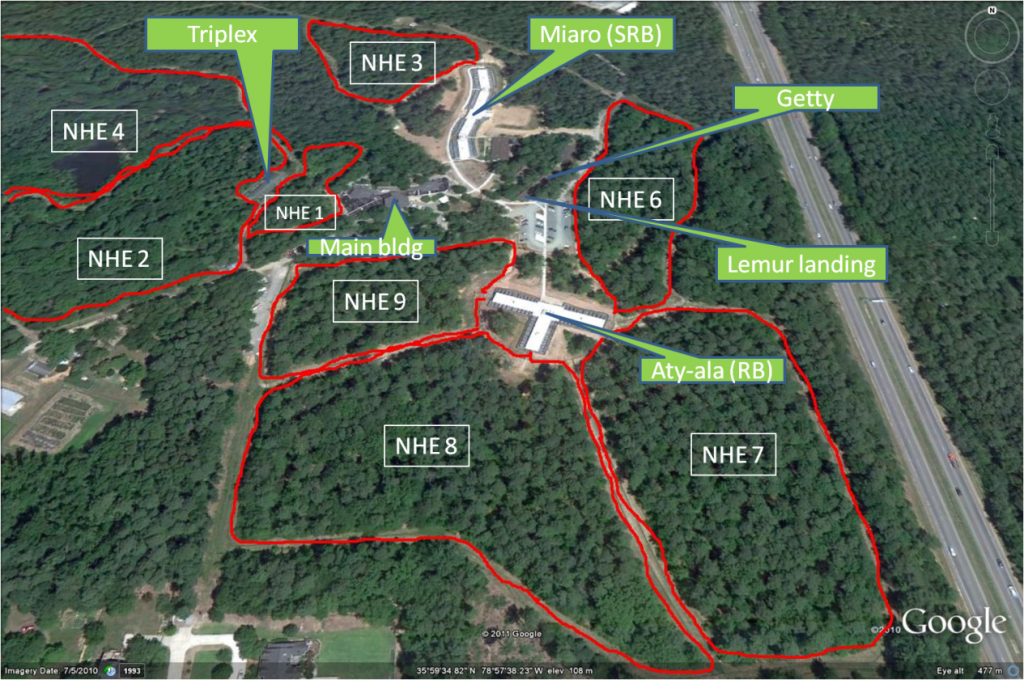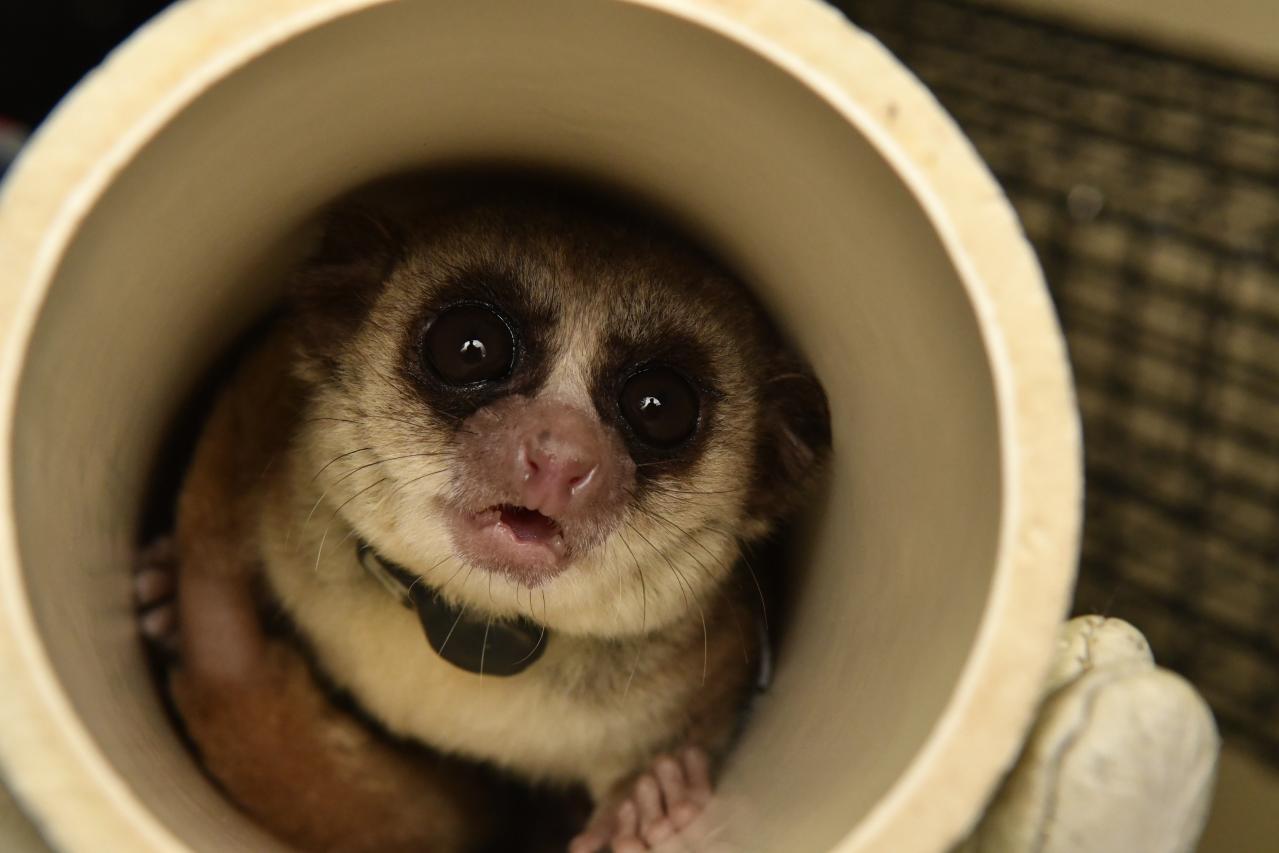The DLC has two in-house research themes, occurring on-site and in Madagascar, that are spearheaded by DLC scientists: hibernation and vertebrate paleontology. The DLC also facilitates research led by external researchers, including students, postdoctoral fellows, and faculty from across the globe. We welcome new researchers and new projects.
All of this work has resulted in the creation and maintenance of vast quantities of data, made even more powerful when presented relationally. Our hope is that, by sharing these data on GBIF and encouraging other researchers and institutions to do the same, we will greatly increase the availability and accessibility of lemur-related biodiversity data.
Husbandry practices
The Duke Lemur Center houses nearly 250 lemurs and bush babies across 12 species — the most diverse population of lemurs on Earth, outside their native Madagascar.
Natural Habitat Enclosures
All of our lemurs live in enclosures with indoor/outdoor access. Each group has access to multiple enclosures. For example, a group of four lemurs will have access to four connecting indoor areas with four connecting outdoor yards. Thus they are set up for research trials that require access to any animal singly or any combination of animals from that group as they can be easily temporarily shifted to accommodate the needs of the researchers.
During the warm months of the year (typically mid-April to mid-October), approximately half of our diurnal lemurs also have access to free-range enclosures (called NHEs or “Natural Habitat Enclosures”) ranging in size from 1.6 to 14.3 acres. Most of these enclosures contain multiple species and are ideal for observational studies that focus on more naturalistic behaviors.

Lemur Center Portal data
The DLC began publishing data to GBIF via VertNet in 2025. Most datasets contain specimen data but we plan to add checklists, media, and observation data. All datasets are published in the biodiversity information standard Darwin Core, and you can explore, download and use them for free under a non-commercial license.
Colony data
Since its establishment in 1966, the DLC has accumulated detailed records for over 4300 individuals from over 40 closely related yet biologically diverse primate taxa in our care, including ancestry, reproduction, longevity, and body mass. Our institution houses more than 200 individual animals representing 12 species and is home to nocturnal, diurnal, and cathemeral animals, as well as species that encompass a wide range of social systems, modes of locomotion, and dietary preferences. Our colony data also includes a species checklist for all taxa that the DLC has cared for since 1966.
Biobank data
The DLC Research Department maintains a large inventory of vouchered biological samples that are available for scientific study by qualified individuals or institutions. Samples such as blood, serum, and urine are banked opportunistically from our living colony during routine physical exams or other veterinary procedures. Tissues are collected from animals that have died of natural causes. Samples are preserved in a variety of ways suitable for DNA, RNA, and histological analyses. Cadavers are kept frozen and are also available for study.
Fossil, subfossil, and osteological data
The DLC Museum of Natural History is the largest, most diverse collection of fossil primates in North America. Through extensive field work in Madagascar, Egypt, Peru, Colombia, and the United States, our collection also contains non-primate lineages, including bats, proboscideans, crocodilians, birds, rodents, carnivorans, sharks, and anthracotheres. In addition to its fossils and subfossils, the museum is responsible for a collection of osteological specimens from the Duke Lemur Center, from vouchered animals that died of natural causes at the DLC.
Data usage
Datasets provided by the DLC, including text, images, and other media, are freely accessible for educational and research purposes and should not be used for commercial purposes.
If you plan to publish in a peer-reviewed journal using these data, please cite any specimen numbers, which begin “DLC” for our living and biobank collections and “DPC” for fossil and osteology collections. For digital media from MorphoSource, please include the ARK ID of the scan, 3D model, or 2D image you used.
Prior to publication, we ask that you include “This is Duke Lemur Center publication #XXXX” in the Acknowledgements. To get your actual manuscript number, contact us or DLC Research Manager Erin Ehmke (erin.ehmke@duke.edu) when the paper is at the “accepted with revisions” stage.
We are always interested to learn how our data are being used and happy to answer any questions about usage or citations, so please feel free to reach out to the contacts associated with the dataset you are using to share more about your project and/or ask for assistance.
Citations
These are the preferred formats for citing data published by the DLC. If other citation practices apply, feel free to use them, but please include a link.
Aggregated data
Example: Duke Lemur Center, Memphis Zoo, American Museum of Natural History. https://data.lemur.duke.edu/occurrence/ (accessed on 2024-08-29)
Format: [list of data publishers]. https://data.lemur.duke.edu/occurrence/ (accessed on [date])
Single dataset
Example with DOI: Duke Lemur Center Museum of Natural History Egypt Collection. https://doi.org/10.15468/s99gbz (accessed on 2025-08-29)
Format: [dataset name] from [data publisher]. https://doi.org/ [DOI of dataset] (accessed on [date])
Single specimen/observation record
Example: DPC OST 15, Duke Lemur Center Museum of Natural History Osteology Specimens from Duke Lemur Center. https://data.lemur.duke.edu/dataset/e592ecfd-2c81-44e8-82cc-c54c69d8c805 (accessed on 2035-08-29)
Format: [record id], [dataset name] from [data publisher]. [link to dataset] (accessed on [date])
